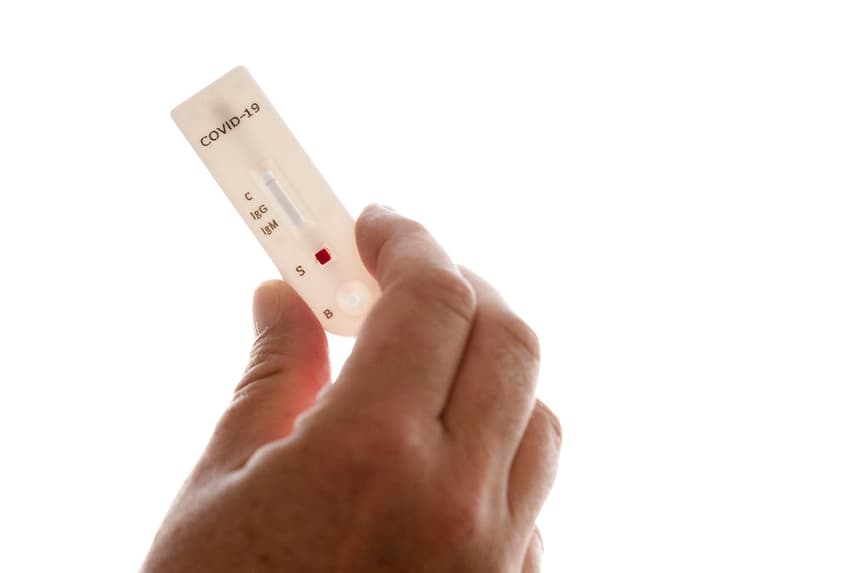Denmark to send out half a million 'unreliable' Covid-19 antibody tests

As part of a broad-ranging study, 500,000 people in Denmark will receive in the near future a coronavirus antibody test kit.
But the test, which involves taking blood with a finger prick, has been reported to be unreliable and not CE-certified for home use.
The issues with the tests were reported by Danish newspaper Politiken.
The CE mark denotes that the producer or importer of a product complies with EU standards.
The tests are reported to have been purchased by Region Hovedstaden, the health authority for greater Copenhagen, in April. A total of 1.4 million antibody tests were purchased from a Chinese partner of Danish clothing company Bestseller for over 60 million kroner, according to the report.
But the tests, produced by Livzon, have since proved to be unreliable to such a degree that health authorities in India have decided to shelve them, according to Politiken.
Nevertheless, 500,000 of the tests are to be sent to people in Denmark as part of the ‘Vi tester Danmark’ (‘We’re testing Denmark) project.
READ ALSO: Denmark to test thousands for Covid-19 antibodies
Recipients will be able to use the tests without qualified personnel to check the results.
“We are using these tests because they are the ones we have available and because they can be conducted at peoples’ homes. For diagnostic use it is hugely important we have a completely correct result, but when we are doing a study of the general public like this, we can live with the test being a bit less precise,” senior doctor Robert Skov of the State Serum Institute (SSI) told Politiken.
SSI, the national infectious disease agency, is carrying out the study along with regional health authorities.
Skov added that SSI will make clear to participants that the result will only be an indication of whether they have formed antibodies.
But faulty results may give participants an incorrect impression that they may have developed immunity to coronavirus, according to Peder Hvelplund, health spokesperson with the Red Green Alliance (Enhedslisten) party.
“We are risking some people using the test and getting a false answer, and thereby risking that they will end up acting as if they actually have antibodies and therefore don’t need to worry about getting infected,” Hvelplund told Ritzau.
Comments
See Also
But the test, which involves taking blood with a finger prick, has been reported to be unreliable and not CE-certified for home use.
The issues with the tests were reported by Danish newspaper Politiken.
The CE mark denotes that the producer or importer of a product complies with EU standards.
The tests are reported to have been purchased by Region Hovedstaden, the health authority for greater Copenhagen, in April. A total of 1.4 million antibody tests were purchased from a Chinese partner of Danish clothing company Bestseller for over 60 million kroner, according to the report.
But the tests, produced by Livzon, have since proved to be unreliable to such a degree that health authorities in India have decided to shelve them, according to Politiken.
Nevertheless, 500,000 of the tests are to be sent to people in Denmark as part of the ‘Vi tester Danmark’ (‘We’re testing Denmark) project.
READ ALSO: Denmark to test thousands for Covid-19 antibodies
Recipients will be able to use the tests without qualified personnel to check the results.
“We are using these tests because they are the ones we have available and because they can be conducted at peoples’ homes. For diagnostic use it is hugely important we have a completely correct result, but when we are doing a study of the general public like this, we can live with the test being a bit less precise,” senior doctor Robert Skov of the State Serum Institute (SSI) told Politiken.
SSI, the national infectious disease agency, is carrying out the study along with regional health authorities.
Skov added that SSI will make clear to participants that the result will only be an indication of whether they have formed antibodies.
But faulty results may give participants an incorrect impression that they may have developed immunity to coronavirus, according to Peder Hvelplund, health spokesperson with the Red Green Alliance (Enhedslisten) party.
“We are risking some people using the test and getting a false answer, and thereby risking that they will end up acting as if they actually have antibodies and therefore don’t need to worry about getting infected,” Hvelplund told Ritzau.
Join the conversation in our comments section below. Share your own views and experience and if you have a question or suggestion for our journalists then email us at [email protected].
Please keep comments civil, constructive and on topic – and make sure to read our terms of use before getting involved.
Please log in here to leave a comment.